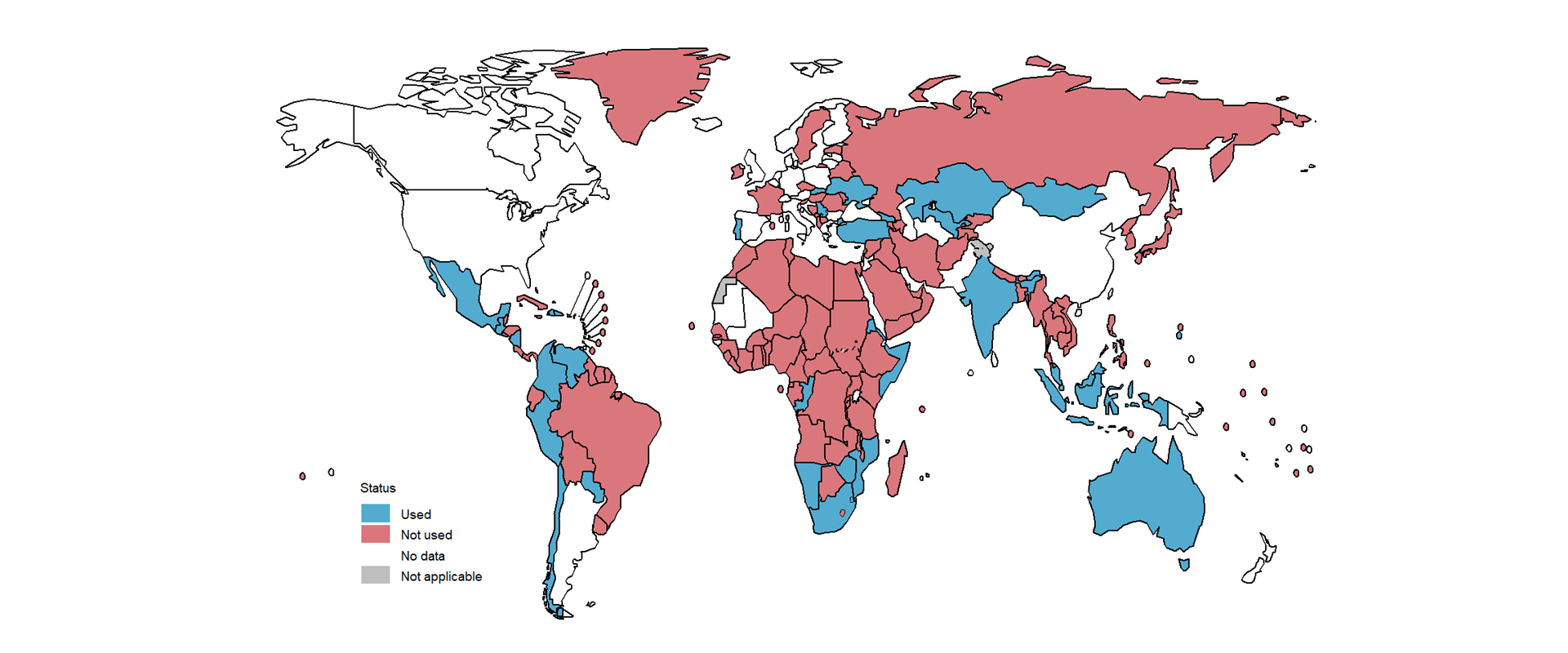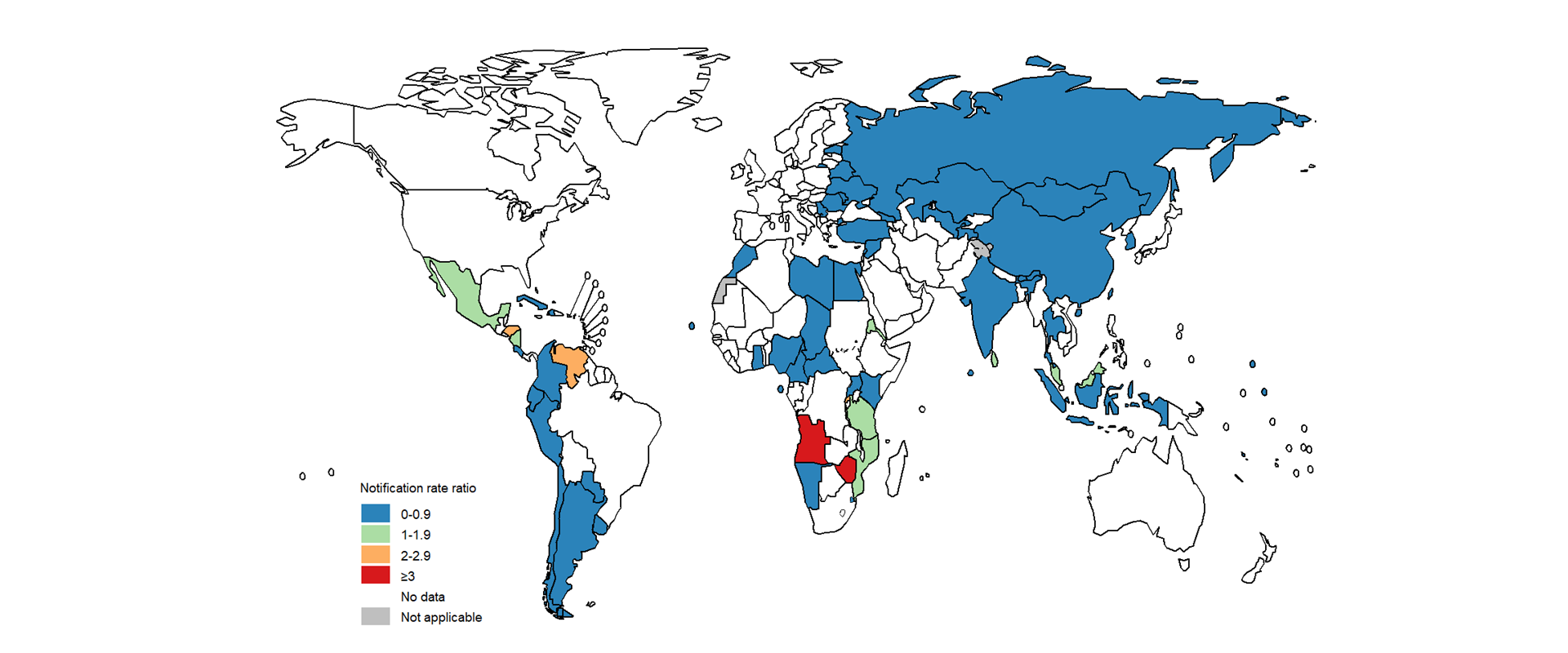
3. Tuberculosis prevention and screening
Preventing tuberculosis (TB) infection and stopping progression from infection to disease are critical for reducing TB incidence to the levels envisaged by the End TB Strategy (1, 2). The main health care intervention to stop progression from infection to disease is TB preventive treatment (TPT), which the World Health Organization (WHO) recommends for people living with HIV, household contacts of people with TB and other risk groups (3, 4). Strategies to provide TPT are often linked to screening to find and treat people with TB earlier in the course of their disease and thus help to reduce transmission and improve outcomes (4). Other TB preventive approaches are TB infection prevention and control (5) and vaccination of children with the bacille Calmette-Guérin (BCG) vaccine. Addressing broader determinants that influence TB epidemics can also help to prevent TB infection and disease; these are discussed in Section 5.3.
3.1 TB preventive treatment
The global number of people living with HIV and household contacts of people diagnosed with TB who were provided with TPT increased from 1.0 million in 2015 to 3.6 million in 2019. There was then a sizeable reduction to 2.9 million in 2020 and 2021, probably reflecting disruptions to health services caused by the coronavirus (COVID-19) pandemic (Fig. 3.1). There was a substantial recovery to 3.9 million in 2022, above the pre-pandemic level, and a further large increase in 2023 to 4.7 million.
Since 2021 there has been a particularly noticeable increase in the number of household contacts enrolled on TPT: from 0.76 million in 2021 to 2.7 million in 2023. In contrast, the number of people living with HIV who were enrolled on TPT increased between 2015 and 2019 (reaching a peak of 3.0 million in 2019) before falling in 2020 and subsequently levelling off at about 2 million people per year.
At the second United Nations (UN) high-level meeting on TB in September 2023, a new global target for TPT coverage was set (6). The target is to reach 90% coverage among people at high risk of developing TB disease by 2027; in absolute numbers, this is equivalent to providing TPT to up to approximately 45 million people globally in the 5-year period 2023–2027, including approximately 30 million household contacts of people with TB and approximately 15 million people living with HIV (see also Table 1 of the core report document).
TPT coverage has improved globally since 2015, but remained well below the target in 2023, for both household contacts (21%) and people with HIV (56%) (Fig. 3.2).
Ensuring access to shorter rifamycin-containing regimens may help to increase access to TPT. In 2023, 1.0 million people started shorter regimens in 86 countries (Fig. 3.3). Among these 86 countries, 77 countries reported using the 3-month weekly regimen of rifapentine and isoniazid (3HP) and 20 reported using the 1-month daily regimen of rifapentine and isoniazid (1HP). Rifampicin-based regimens were also being used in 2023: 76 countries reported using the 3-month daily regimen of rifampicin and isoniazid (3HR) and 41 reported using the 4-month daily regimen of rifampicin only (4R).
(a) Regimens containing rifapentine (1HP and/or 3HP)a

(b) Regimens containing rifampicin (3HR and/or 4R)

(c) Regimens containing levofloxacin (6Lfx)

The newly recommended regimen of 6 months of levofloxacin (6Lfx) for contacts of people with MDR-TB was used in 33 countries, including both high TB burden countries (the Congo, India, Indonesia, Mongolia, Mozambique, Namibia and South Africa) and high MDR-TB burden countries (Kazakhstan, Peru, Somalia, Ukraine, Uzbekistan and Zimbabwe).
3.2 Household contacts
Globally in 2023, there were an estimated 13 million (95% uncertainty interval [UI]: 13–14 million) household contacts of people diagnosed with bacteriologically confirmed pulmonary TB. However, only 9.3 million contacts were reported in 2023 (up 3.5% from 9.0 million in 2022); 7.9 million (85%) of these contacts were evaluated for both TB infection and disease (up 9.4% from 7.2 million in 2022). The percentage of contacts who were evaluated varied widely among countries (Fig. 3.4).
A total of 2.1 million household contacts aged 5 years and over started TPT in 2023, representing a 52% increase compared with 2022 (Fig. 3.1). India and Nigeria accounted for over half of this increase.
In 2023, 0.67 million household contacts aged under 5 years started TPT out of an estimated 1.6 million who were eligible – a 12% increase compared with 2022.
Globally, the 2.7 million household contacts provided with TPT in 2023 represented about 29% of the 9.3 million household contacts reported and 21% of the estimated total of 13 million household contacts. There was considerable variation among countries in both the percentage of household contacts who were evaluated for TB disease and infection, and the percentage of household contacts who were provided with TPT (Fig. 3.4, Fig. 3.5).


Data on completion of TPT among household contacts who started treatment in 2022 was reported by 85 countries; the median completion rate was 87% (interquartile range [IQR], 74–95%), but rates varied widely among WHO regions (Fig. 3.6).
Globally, the cascade of TB preventive care shows a big gap between the number of household contacts screened for TB disease and the number starting TPT (Fig. 3.7).
3.3 People living with HIV
Globally, the annual number of people living with HIV who received TPT increased from fewer than 30 000 in 2005 to 3.0 million in 2019 (Fig. 3.8). Subsequently, reported numbers fell for 3 years before stabilizing at 2.0 million in 2023. Possible reasons for the reductions between 2020 and 2022 include disruptions to health services caused by the COVID-19 pandemic and changes in data collection. In a few countries, achievement of full TPT coverage among people living with HIV already on ART has also restricted new enrolments on TPT to people newly enrolled on ART.
Eight high TB/HIV burden countries, accounting for 50% of the estimated global number of people living with HIV who developed TB in 2023, each provided TPT to more than 100 000 people living with HIV in 2023, and collectively accounted for 1.5 million (78%) of the global total in 2023: India, Kenya, Mozambique, Nigeria, South Africa, the United Republic of Tanzania, Zambia and Zimbabwe.
Between 2005 (the year following the publication of the first WHO policy guidance on collaborative TB/HIV activities) and the end of 2023, 19 million people living with HIV were initiated on TPT, equivalent to just under half of the 39.9 million people estimated to be living with HIV in 2023 (7, 8).
Among 70 countries that reported data, a median of 35% (IQR: 8.5–63%) of people living with HIV who were newly started on antiretroviral therapy (ART) received TPT in 2023.
In 42 countries that reported data, a median of 83% (IQR: 67–95%) of people living with HIV who started TPT in 2022 completed their treatment (Fig. 3.9).
3.4 Screening for TB disease in household contacts and other high-risk groups
Among 125 countries that reported the results of TB screening in household contacts in 2023, the overall yield of people with TB was 2.0% (median: 1.7%; IQR: 0.44–3.8%) (Fig. 3.10). This is slightly lower than what would be expected in household contacts of people with bacteriologically confirmed TB (9). The wide variation among countries probably reflects differences in the coverage of screening for eligible individuals, the diagnostic algorithms being used and the completeness of reporting.
In 2023, 111 countries reported the number of people newly diagnosed with TB who were identified through provider-initiated screening efforts in high-risk groups such as contacts, people living with HIV, people in prisons and mining communities, and through facility-based screening of people with diabetes and other groups (Fig. 3.11).
In 2023, 52 out of 66 priority countries reported data about the availability of chest radiography for regular TB screening or active TB case-finding campaigns. Of those 52 countries, 28 (54%) reported the regular use of chest radiography – with or without computer-aided detection software – in 75% or more of administrative units in the country (median coverage for 52 countries: 89% of administrative units, IQR: 25–100%).

3.5 Tests for TB infection
Tests for TB infection can help to target TPT to people who can gain the most benefit from it. In 2023, 112 countries reported using tuberculin skin tests (TST) or interferon gamma release assays (IGRA) in either the public or private sectors to deliver TPT to populations at risk (Fig. 3.12). A further 12 countries reported using antigen-based skin tests in addition to IGRA or TST. Of the 38 countries reporting no use of tests for TB infection, 27 were in the WHO African Region.

3.6 TB infection prevention and control
The risk of TB among health care workers relative to the risk in the general adult population is one of the indicators that WHO recommends for measuring the impact of TB infection prevention and control interventions in health care facilities. If effective prevention measures are in place, the risk ratio for TB in health care workers compared with the general adult population should be close to 1.
In 2023, 17 449 health care workers from 73 countries were reported to have been diagnosed with TB. The ratio of the TB notification rate among health care workers to the general adult population was greater than 1 in 12 countries that reported five or more health care workers diagnosed with TB (Fig. 3.13).

3.7 Bacille Calmette-Guérin vaccination
Bacille Calmette-Guérin (BCG) vaccination is recommended as part of national childhood immunization programmes, in line with a country’s TB epidemiology (10). However, global coverage dropped from 89% in 2019 to 86% in 2020 and 85% in 2021, probably due to disruptions to health services caused by the COVID-19 pandemic. There was a recovery back to 88% in 2022 and 87% in 2023 (Fig. 3.14) (11).
References
The End TB strategy. Geneva: World Health Organization; 2015 (https://iris.who.int/handle/10665/331326).
WHA67.1: Global strategy and targets for tuberculosis prevention, care and control after 2015. Geneva: World Health Organization; 2014 (https://apps.who.int/gb/ebwha/pdf_files/WHA67-REC1/A67_2014_REC1-en.pdf#page=25).
WHO consolidated guidelines on tuberculosis. Module 1: Prevention – Tuberculosis preventive treatment, second edition. Geneva: World Health Organization; 2024 (https://iris.who.int/handle/10665/378536).
WHO consolidated guidelines on tuberculosis. Module 2: Screening – Systematic screening for tuberculosis disease. Geneva: World Health Organization; 2021 (https://iris.who.int/handle/10665/340255).
WHO guidelines on tuberculosis infection prevention and control. 2019 update. Geneva: World Health Organization; 2019. (https://iris.who.int/handle/10665/311259).
Resolution 78/5: Political declaration of the high-level meeting of the General Assembly on the fight against tuberculosis. New York: United Nations; 2023 (https://undocs.org/A/RES/78/5).
UNAIDS epidemiological estimates, 2023 (https://aidsinfo.unaids.org/).
Interim policy collaborative TB/HIV activities. Geneva: World Health Organization; 2004 (https://iris.who.int/handle/10665/78705)
Fox GJ, Barry SE, Britton WJ, Marks GB. Contact investigation for tuberculosis: a systematic review and meta-analysis. European Respiratory Journal. 2013 Jan 1;41(1):140–56. (https://erj.ersjournals.com/content/41/1/140).
Weekly Epidemiological Record, 2018, vol. 93, 08, 73 - 96. Geneva: World Health Organization; 2018. (https://iris.who.int/handle/10665/260306).
The WHO Global Health Observatory (https://www.who.int/data/gho/data/indicators/indicator-details/GHO/bcg-immunization-coverage-among-1-year-olds-(-)). Data downloaded 25 July 2024.
